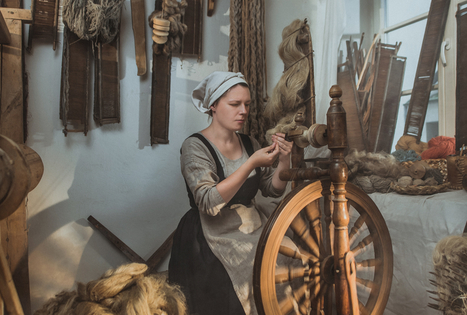Rural people used to raise sheep and sow flax and hemp, and they would spend the long autumn and winter evenings spinning yarn themselves. It was customary to give the girl you liked a nicely carved distaff. Spinning with a distaff given as a gift used to mean silent agreement to marry.
The oldest method – finger twisting
Man already knew how to spin in the Stone Age, during the 12th–10th millennium BC. The oldest method of spinning involved twisting flax fibres with your fingers. This is how many nations around the world used to spin. During the 5th millennium BC, people invented the first spinning tool – the spindle. This is a tapered round stick fitted with a whorl made of clay, stone or amber or cut from the same piece of wood. At first, you had to draw out the filament from the fibrous material, twist it into a small tuft, and attach it to the spindle.
In China, during the times of the Western Han dynasty (206 BC–AD 25), an unknown inventor mounted a spindle on an axle driven by a wheel that was spun by hand. This is how the spinning wheel came about.
Spinning wheels did not come to Europe until the 13th century. Here they were also rotated by hand. It is estimated that 250 years later, a spinning wheel with a treadle was constructed in England.
It is unknown when the spinning wheel appeared in Lithuania
Wooden spindles were the main spinning tools in Lithuania until the beginning of the 19th century, even though they were already being pushed out by the spinning wheel by that time. It is difficult to determine when the wheel appeared in our area. According to Kristijonas Donelaitis, East Prussian Lithuanians were using spinning wheels in the first half of the 18th century. It was usually wool, flax or hemp fibres that were spun.
It is believed that the first spinning wheels came to Lithuania from Germany. Some Lithuanian estates already had them in the 16th–17th centuries, and in the first half of the 18th century, serfs were using them as well. At first, the spinning wheel was a rare and expensive item, so even in the 19th century, not all peasants could afford one. Families of middle and poor peasants usually had one wheel each, and some women still used spindles for spinning. Spinning wheels appeared in eastern and south-eastern Lithuania even later – from the late 19th century to the early 20th century.
From the spindle to companies
Women usually spun in winter when they had less farm work. Yarn was spun not only for the estate, but for the family as well. Up until the end of the 19th century, and in some places – in the first half of the 20th century as well, rural women would get together to spin and spend the evening together. They would race, tell stories, sing and treat themselves to something tasty. In the beginning of the 20th century, townswomen also spun wool and flax for peasants, either for money or for payment in-kind, with artisans eventually emerging who used spinning machines.
Spinning manufactories was established in the 18th century. Count A. Tyzenhaus set up one of the first ones in Gruzdžiai (later – in Grodno). In the 19th century, yarn was spun at manufactories in some estates, and in the beginning of the 20th century – at the Juodupė woollen fabric factory and other small companies. Most of the wool and linen weaving companies in the first half of the 20th century had spinning mills. In the second half of the 20th century, large spinning and weaving factories were built in Vilnius, Panevėžys, Kaunas, Alytus and Marijampolė.
There are currently 10 certified spinners in Lithuania who primarily produce wool, linen, hemp and nettle yarn.














































